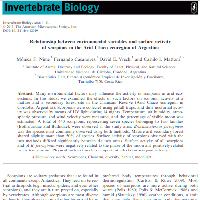Resumen
-
Many environmental factors may influence the activity of scorpions in arid ecosystems. In this study, we examined the effects of such factors on scorpion activity at a mature and a secondary forest site in the Chancaní Reserve (Arid Chaco ecoregion in Córdoba, Argentina). Scorpions were collected using pitfall traps, and their nocturnal activity was observed by means of UV light during 14 nights. Temperature, air humidity, atmospheric pressure, and wind velocity were measured, and the percentage of visible moon was estimated. A total of 440 scorpions, representing seven species belonging to two families (Bothriuridae and Buthidae), were observed in the study area. Brachistosternus ferrugineus was the species most commonly observed using both methods. Mature and secondary forest shared slightly more than 50% of species. Surface activity of scorpions observed with the two methods differed significantly between the two areas. Surface activity of all scorpions and of B. ferrugineus were negatively related to the phase of the moon and positively related to air temperature. Physical factors thus have important effects on scorpion activity.
